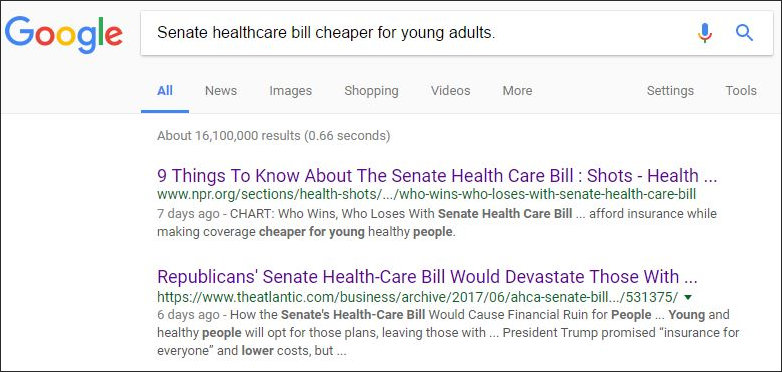
Only 18% of Americans support the U.S. Senate healthcare bill to replace Obamacare, says one poll. Only 12%, says another, and only 8% says yet another. Given the slow-motion collapse of Obamacare, that’s remarkably low. With numbers that low, even a majority of Republicans must oppose the bill.
Could the public’s negative opinion be shaped by the fact that the media has overwhelmingly portrayed the bill in overwhelmingly negative, even apocalyptic, terms?
A big drawback of the bill is that health care insurance would be more expensive for older Americans. I Googled the phrase, “Senate healthcare bill more expensive for older adults.” Every article cited on the opening page stressed the harm that the bill would do to seniors. Seventy-five percent of Googlers never go past the first page of results. To find countervailing analysis, searchers would have to dive way deeper into the results.
An offsetting benefit is that the bill would make health care insurance cheaper for young adults and free them from the Obamacare mandate of purchasing insurance. So, I Googled the phrase, “Senate healthcare bill cheaper for young adults.” The opening page was a mixed bag. Some results were balanced and some negative. None were positive. Here are the headlines:
9 Things To Know About The Senate Health Care Bill (NPR). The article notes, “The oldest people under 65 can be charged five times more than the youngest, and maybe more depending on state rules.” It says nothing about young adults paying less.
How the Senate’s Health-Care Bill Would Cause Financial Ruin for People with Preexisting Conditions (Atlantic). The headline speaks for itself. The article doesn’t even address the issue of how young people are impacted.
Winners and Losers of the Senate’s Health-Care Bill (CNBC). This article does acknowledge that young adults would benefit: “The Senate plan, like the House bill, would give insurers greater flexibility to charge younger enrollees much lower premiums and to offer skinnier plans in states that opt out of ACA’s essential health benefit requirements.”
The Senate health care bill: What’s in it and what to watch for in the CBO report (Politifact). This article provides a balanced statement: “Today, companies can’t charge older customers more than three times what young adults pay. The Senate bill increases that to five to one. This change reduces premiums for the young and increases them for those in their 50s and early 60s.”
Senate health plan falls short of promise for cheaper care, experts say (New York Times). The Times article presents a uniformly dismal view of the bill, noting no positives of any kind.
Senate Health Bill Includes Deep Cuts to Medicaid (New York Times). This Times article tells how older Americans would be disadvantaged under the bill but ignores the offsetting advantages to younger Americans. “Older people could be disproportionately hurt because they pay more for insurance in general. Both chambers’ bills would allow insurers to charge older people five times as much as younger ones; the limit is now three times.”
The Senate health bill is brutal on older Americans (Slate). The first paragraph in this Slate article is as balanced as it gets: “One of the expressed intentions of Republicans’ efforts to repeal and replace Obamacare is to undo some of the age-related distribution inherent in the system. Today, healthy young people pay more so that older, less-healthy people don’t have to pay quite as much.” Then Slate goes relentlessly negative for the rest of the article.
Comparing the Senate health care bill to Obamacare and the House proposal (CNN). This CNN article does note that the Senate bill will repeal the mandate for adults to obtain health insurance or pay a penalty.
Senate health care bill would lower deficit, increase number of insured, estimate says (FOX). The Fox article addresses pros and cons of the bill, but nowhere does it mention how the bill would lower premiums for young adults.
The Senate health-care bill’s subsidy cuts hurt low-income, older Americans (Washington Post). While the headline is negative, the article itself is more balanced, acknowledging that young people would benefit from allowing insurers to base rates on age. “Both [the House and Senate] bills include changes that would mean older people pay more and younger people pay less.”
Summary: The results on a search inquiring about a negative aspect of the bill brings up uniformly negative and critical articles. The results on a search inquiring about a positive aspect of the bill brings up a mix of negative and balanced articles — but no positive articles.
What does it mean? Mainstream media coverage of the bill has been overwhelmingly negative. No surprise there. But what if someone wants to cut through the media filter to find “the other side” of the story — to look for positives? Good luck using Google. Microsoft’s Bing search tool provides slightly less biased results, bringing up a Wall Street Journal article. But even Bing results reflect the implacable media coverage.
At least the media isn’t making up stuff from whole cloth in this health care debate, as it has with the Trump-Russia-conspiracy obsession. There are, in fact, downsides to complex legislation like Obamacare repeal. But you have to be highly motivated to find a sympathetic view of the Republican bill.
Here’s the political dynamic at work: Mainstream media coverage is ferociously negative, and anyone wanting to hear the Republican view of how the legislation works finds it difficult to break through the Google filter. Knowing nothing about the legislation than what they’ve seen in the media, Americans express their disapproval in public opinion polls. The inevitably dismal polls spook undecided Republicans to oppose the bill.
With its ability to frame issues, set agendas and slant news, the media truly is the fourth estate — it is every bit as powerful as the executive, judicial and legislative branches of the government. Given the media’s biases, I find that terrifying.


